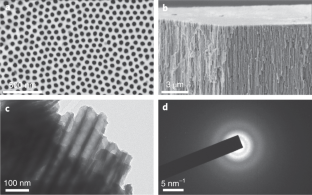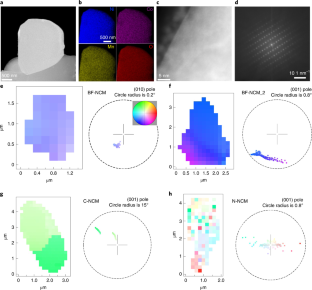電池セルは、充放電することで電極材料が “超 “材料に変化する。 Charging and discharging a battery cell transforms its electrode material into a “super” material.
2022-09-08 アルゴンヌ国立研究所(ANL)
五酸化ニオブは、メッキの影響を受けにくいため、グラファイトよりも安全で耐久性に優れている可能性があります。さらに、原子はさまざまな安定した配置をとることができ、再構成するのにそれほどエネルギーを必要としない。
今回、研究チームは、五酸化ニオブを電極材料とするコイン電池を作製した。(コイン電池は、ボタン電池とも呼ばれ、円形の小型の電池デバイスである)。五酸化ニオブは、原子が無秩序に配置されたアモルファス構造をしていた。この電池を何度も充放電させると、無秩序な構造が秩序ある結晶構造に変化する。
この結晶構造は、乱れた配列に比べて、充電時にリチウムイオンをより容易に、より速く負極に輸送することが可能であった。この発見は、この材料が高速充電に適していることを示しており、他の測定結果からも、大量の電荷を蓄えることができることが示唆されている。
ニオブ原子は、セルが充電されるにつれて複数の電子を獲得することが明らかになり、アノードが高い貯蔵能力を持つことを示唆している。
この技術によって、ニオブが複数の電子を獲得していることが確認された。
<関連情報>
- https://www.anl.gov/article/scientists-use-novel-method-to-make-promising-battery-material
- https://www.nature.com/articles/s41563-022-01242-0
リチウムイオン電池用ニオブ酸化物電極における電気化学的に誘起されたアモルファス-岩塩相転移 Electrochemically induced amorphous-to-rock-salt phase transformation in niobium oxide electrode for Li-ion batteries
Pete Barnes,Yunxing Zuo,Kiev Dixon,Dewen Hou,Sungsik Lee,Zhiyuan Ma,Justin G. Connell,Hua Zhou,Changjian Deng,Kassiopeia Smith,Eric Gabriel,Yuzi Liu,Olivia O. Maryon,Paul H. Davis,Haoyu Zhu,Yingge Du,Ji Qi,Zhuoying Zhu,Chi Chen,Zihua Zhu,Yadong Zhou,Paul J. Simmonds,Ariel E. Briggs,Darin Schwartz,Shyue Ping Ong & Hui Xiong
Nature Materials Published:02 May 2022
DOI:https://doi.org/10.1038/s41563-022-01242-0

Abstract
Intercalation-type metal oxides are promising negative electrode materials for safe rechargeable lithium-ion batteries due to the reduced risk of Li plating at low voltages. Nevertheless, their lower energy and power density along with cycling instability remain bottlenecks for their implementation, especially for fast-charging applications. Here, we report a nanostructured rock-salt Nb2O5 electrode formed through an amorphous-to-crystalline transformation during repeated electrochemical cycling with Li+. This electrode can reversibly cycle three lithiums per Nb2O5, corresponding to a capacity of 269 mAh g−1 at 20 mA g−1, and retains a capacity of 191 mAh g−1 at a high rate of 1 A g−1. It exhibits superb cycling stability with a capacity of 225 mAh g−1 at 200 mA g−1 for 400 cycles, and a Coulombic efficiency of 99.93%. We attribute the enhanced performance to the cubic rock-salt framework, which promotes low-energy migration paths. Our work suggests that inducing crystallization of amorphous nanomaterials through electrochemical cycling is a promising avenue for creating unconventional high-performance metal oxide electrode materials.



